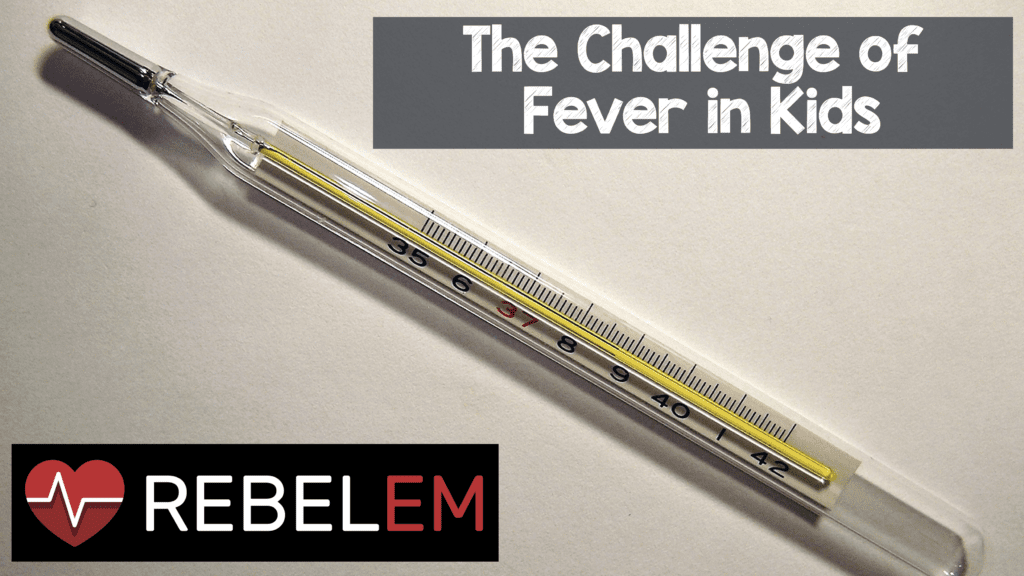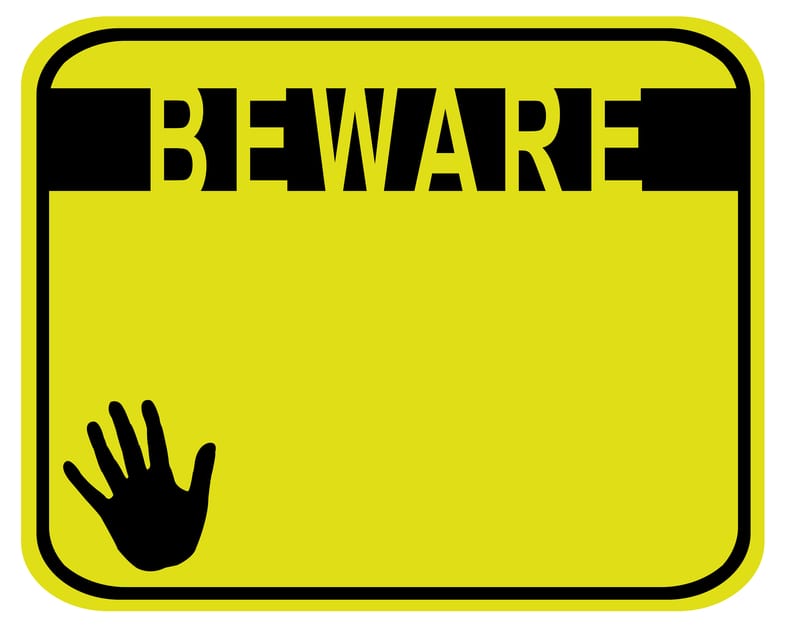
 FEVER shows up beside the name of a new 3 year old that has just been checked into your department. This can be accompanied by many feelings when you see it from “Why are they here ?” to “I hope the child is not dying.” This is a reasonable range of thoughts depending on your level of experience and resources. Many variables are important with this “chief complaint” from how the temperature was actually obtained, to immunization status of the child, to how does the child look, and many more. In my estimation, fever gets a bad rap from general society. It’s our job to set the tone and fight “fever-phobia” when needed. Let’s examine some aspects of pediatric fever to change your mindset from apprehension, to “I’ve got this”.
FEVER shows up beside the name of a new 3 year old that has just been checked into your department. This can be accompanied by many feelings when you see it from “Why are they here ?” to “I hope the child is not dying.” This is a reasonable range of thoughts depending on your level of experience and resources. Many variables are important with this “chief complaint” from how the temperature was actually obtained, to immunization status of the child, to how does the child look, and many more. In my estimation, fever gets a bad rap from general society. It’s our job to set the tone and fight “fever-phobia” when needed. Let’s examine some aspects of pediatric fever to change your mindset from apprehension, to “I’ve got this”.
Beware of Fever in…
 For the sake of this post, we are discussing the febrile child over 6 months (considered “fully immunized” due to the fact that they have received all 3 initial doses of Hib and Pneumovax (at 2m, 4m, and 6m) [1]. There is enough gray area and debate especially from the 28 day to 3 month group that we will need to tackle that population in a future post.
For the sake of this post, we are discussing the febrile child over 6 months (considered “fully immunized” due to the fact that they have received all 3 initial doses of Hib and Pneumovax (at 2m, 4m, and 6m) [1]. There is enough gray area and debate especially from the 28 day to 3 month group that we will need to tackle that population in a future post.
Also for the sake of the post, when I refer to viral illness, I am referring to the common, almost-always, self-limited viruses like rhinovirus, adenovirus, metapneumovirus etc. As we have all heard…ebola is a virus.
This post also does not deal with the high risk pediatric group of heme-onc patients, short-gut patients, sickle-cell patients, transplant patients, patients with a central line, or patients on any type of immune-suppressive therapy. All in that group with fever should be approached with extreme caution.
This post also does not apply to any child that is toxic appearing (especially with any signs of poor perfusion), or that has had fever for more than 5 continuous days. Over 5 days of fever may indicate Kawasaki’s disease, secondary bacterial infection, malignancy, drug reaction etc.
We will also assume that we are dealing with a core temperature (oral or rectal). This point is important to know what is used in triage in the department you are working. Many facilities have gone to more “patient/parent friendly” modes of temperature measurement at the sacrifice of the gold standard of temperature measurement [2][3]. Since we are discussing temp and your subsequent work-up, treatment etc in this post, make sure if the number will affect your decision or does not match up with the clinical picture, that you insist on getting a core temp on the child in your department.
What is our goal?
 As we know and may have to remind the parents, fever is not a diagnosis or a disease. It is usually the body’s response to an infectious agent (which is commonly viral in the immunized population). Yet, we who work in the ED, should always be aware of and actively looking for the worst cause of a potentially deadly sign or symptom. This is the mindset of what we do. Every febrile child visit to the ED should start with the thought that we are efforting to rule out SBI (Serious Bacterial Illness). SBI is defined as a bacterial infection with significant risk of progression and danger to the patient if untreated.
As we know and may have to remind the parents, fever is not a diagnosis or a disease. It is usually the body’s response to an infectious agent (which is commonly viral in the immunized population). Yet, we who work in the ED, should always be aware of and actively looking for the worst cause of a potentially deadly sign or symptom. This is the mindset of what we do. Every febrile child visit to the ED should start with the thought that we are efforting to rule out SBI (Serious Bacterial Illness). SBI is defined as a bacterial infection with significant risk of progression and danger to the patient if untreated.
SBI can come in many forms. Definitive SBIs include pneumonia, septic joint, abscess (retropharangeal, cutaneous), meningitis, cellulitis, myocarditis, pyelonephritis, osteomyelitis, appendicitis and other “itis’es.
Most of the time, ruling these out can be accomplished with a good history and physical exam (which includes a reliable set of vitals). This can allow us to be confident in sending the child home from our emergency department. It also helps that the majority of fever (even in hospitalized children) is viral in origin [4][5].
Do I need a WBC count or other labs to rule out SBI?
A significant portion of literature speaks against any particular lab test being more useful than the clinical history and appearance of the child on exam [6][7]. There are validated prediction models being used in other countries that have the “how do they look” component paired with labs like C-Reactive protein [8]. Although there is inconsistent literature on inflammatory markers to detect SBI, Procalcitonin has earned a spot in the discussion [9]. There is even a “lab score” which is a combination of CRP, Procalcitonin, and Urine dipstick. Unfortunately for those in the emergent setting, that score has proven to be better at ruling SBI “in” than “out” [10].
As with all lab tests, what will I do if it is abnormal? The primary conundrum you can get yourself into, is a “above normal limit” WBC count, CRP, or Procalcitonin in a kid that looks really good. The “silver bullet” lab of ruling out SBI remains elusive. Clinical evaluation and judgment remain paramount.
Time and antipyretics can be our friend.
 Let’s face it, fever makes most kids feel bad to terrible. This is why I am a huge fan of giving a proper dose of antipyretics (10mg/kg Ibuprofen or 15mg/kg Acetaminophen) early in the visit. You already know my affinity for popsicles in the ED. The combination of some time, antipyretic, and a popsicle can turn a puny looking child from triage into an active, happy kid. To me, no lab test or radiologic study can reassure me more than a child acting like…well a child. Running around, smiling, good eye contact, watching television, playing with your stethoscope, playing with their siblings are all very reassuring signs and help make the case that your work-up may be done at H&P. Remember to document how good the child looks as well. This is all in line with the “old” Yale Observation scale that has been around for a while and at it’s lowest utility teaches us general things to look for in kids to help with sick vs not sick[11][12]. Note: these “observation” scales do not do well in the very young [13]. In the over 3 month age group, it can be clearly stated: how the kid looks counts..alot! Use time, antipyretics, and oral hydration to your advantage.
Let’s face it, fever makes most kids feel bad to terrible. This is why I am a huge fan of giving a proper dose of antipyretics (10mg/kg Ibuprofen or 15mg/kg Acetaminophen) early in the visit. You already know my affinity for popsicles in the ED. The combination of some time, antipyretic, and a popsicle can turn a puny looking child from triage into an active, happy kid. To me, no lab test or radiologic study can reassure me more than a child acting like…well a child. Running around, smiling, good eye contact, watching television, playing with your stethoscope, playing with their siblings are all very reassuring signs and help make the case that your work-up may be done at H&P. Remember to document how good the child looks as well. This is all in line with the “old” Yale Observation scale that has been around for a while and at it’s lowest utility teaches us general things to look for in kids to help with sick vs not sick[11][12]. Note: these “observation” scales do not do well in the very young [13]. In the over 3 month age group, it can be clearly stated: how the kid looks counts..alot! Use time, antipyretics, and oral hydration to your advantage.
Points to make to the parents about fever:
- “Fever is not a disease. It is merely the child’s immune system APPROPRIATELY responding to an infectious process which is viral the majority of the time.”
- “We treat fever with anti-pyretics because it makes the child feel bad, not because fever in and of itself is bad.”
- “The “number” on the thermometer is not nearly as important as how the child looks (interactivity, energy, hydration).”
- “Length of the fever is actually more concerning than height in most cases. If the fever lasts for more than 5 days, the child should at least have a repeat physical exam by a clinician.”
- “Come back if you are worried about the child.”
So once again, it comes down to clarifying our goals with the visit, adjusting our mindset, and educating the parents.
Thanks for reading, and enjoy those kids!
References:
- CDC Recommended Immunization Schedule for Persons Aged 0 Through 18 Years
- Hebbar K et al Comparison of temporal artery thermometer to standard temperature measurements in pediatric intensive care unit patients. Pediatr Crit Care Med. 2005 Sep;6(5):557-61. PMID:16148817
- Odinaka KK et al Temporal artery thermometry in children younger than 5 years: a comparison with rectal thermometry. Pediatr Emerg Care. 2014 Dec;30(12):867-70 . PMID:25407036
- Wei L et al Detection of viral and bacterial pathogens in hospitalized children with acute respiratory illnesses, Chongqing, 2009-2013. Medicine (Baltimore). 2015 Apr;94(16):e742 . PMID:25906103
- Bonzel L et al Frequent detection of viral coinfection in children hospitalized with acute respiratory tract infection using a real-time polymerase chain reaction. Pediatr Infect Dis J. 2008 Jul;27(7):589-94 PMID:18520973
- Purcell K et al Lack of usefulness of an abnormal white blood cell count for predicting a concurrent serious bacterial infection in infants and young children hospitalized with respiratory syncytial virus lower respiratory tract infection. Pediatr Infect Dis J. 2007 Apr;26(4):311-5. PMID:17414393
- McClain MT et al. Longitudinal analysis of leukocyte differentials in peripheral blood of patients with acute respiratory viral infections. J Clin Virol. 2013 Dec;58(4):689-95 PMID: 24140015
- Nijman RG et al. Clinical prediction model to aid emergency doctors managing febrile children at risk of serious bacterial infections: diagnostic study. BMJ 2013 Apr 2;346:f1706 PMID:23550046
- Yo CH et al. Comparison of the test characteristics of procalcitonin to C-reactive protein and leukocytosis for the detection of serious bacterial infections in children presenting with fever without source: a systematic review and meta-analysis. Ann Emerg Med. 2012 Nov;60(5):591-600. PMID:22921165
- Bressan S et al. Diagnostic performance of the lab-score in predicting severe and invasive bacterial infections in well-appearing young febrile infants. Pediatr Infect Dis J 2012 Dec;31(12):1239-44 PMID:22760529
- McCarthy et al Predictive value of abnormal physical examination findings in ill-appearing and well-appearing febrile children. Pediatrics. 1985 Aug;76(2):167-71. PMID: 4022688
- Bang et al Yale Observation Scale for prediction of bacteremia in febrile children Indian J Pediatr. 2009 Jun;76(6):599-604 PMID:19390817
- Baker et al. Failure of infant observation scales in detecting serious illness in febrile, 4- to 8-week-old infants. Pediatrics. 1990 Jun;85(6):1040-3. PMID:2339027
Post Peer Reviewed By: Salim Rezaie (Twitter: @srrezaie)
The post The Challenge of Fever in Kids appeared first on REBEL EM - Emergency Medicine Blog.

